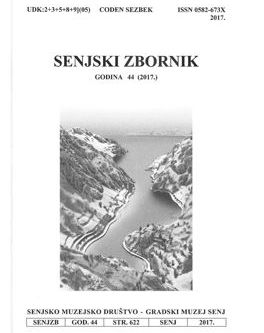Pučka gradnja kao evolucijska sinteza idejne, emotivne i materijalne kompozicijske komponente
Public construction as an evolutional synthesis of a conceptual, emotional and material compositional component
Author(s): Helena Knifić SchapsSubject(s): Agriculture, Energy and Environmental Studies, Human Geography, Regional Geography, Historical Geography, Transport / Logistics
Published by: Senjsko muzejsko društvo i Gradski muzej Senj
Keywords: Public construction; valorisation; national identity; indigenous community; spatial development;
Summary/Abstract: Podgorje public construction is an indispensable component of the spatial and spiritual makeup of the Croatian national being Man’s age-old life in Podgorje, in the foothills of Velebit, has always been linked essentially to the mountain, with the constant seasonal migrations and visits for grazing and water. It could be said that the public construction the people of Podgorje, both that along the sea and in the higher regions, represents "architecture created by purpose", firmly based on the need, landscape, climate, function and with local material. From the aspect of the architectural profession it is insufficiently documented and valorised, which is due to the marginality of the theme, lack of interest, the size of the area over which it is spread and the movement of the permanent population, and this is also partly due to the harsh andi naccessible terrain. Recently the whole region has come under some level of nature protection(from UNESCO’s to national), where for the life of the indigenous population and its architectural fund understanding is difficult to find. The insights and investigations have intensified over the last20 or so years, concluding mainly on the abandonment and deterioration of most of the hamlets, the settings and individual structures. The houses, farm buildings, agricultural areas, chapels and alike, in a derelict condition, are just scarcely inhabited settlements. The paper gives an insight into the results of the field investigations of the residential construction published in the book ‘Velebit arhitektonski, Pučka gradnja u dijelovima Sjevernogi Srednjeg Velebita’ (‘Velebit architectural, public construction in parts of Northern and CentralVelebit’), as well as considerations about the possibilities and directions of spatial development, and their foundations in applicable laws and spatial-planning regulations. The author questions the role of politics and the professional community in the sustainable development of protected, yet depopulated regions, the survival and importance of indigenous populations in the protection of nature, and the architectural heritage of public architecture as a component of the national identity.
Journal: Senjski zbornik - prilozi za geografiju, etnologiju, gospodarstvo, povijest i kulturu
- Issue Year: 44/2017
- Issue No: 1
- Page Range: 253-274
- Page Count: 22
- Language: Croatian

